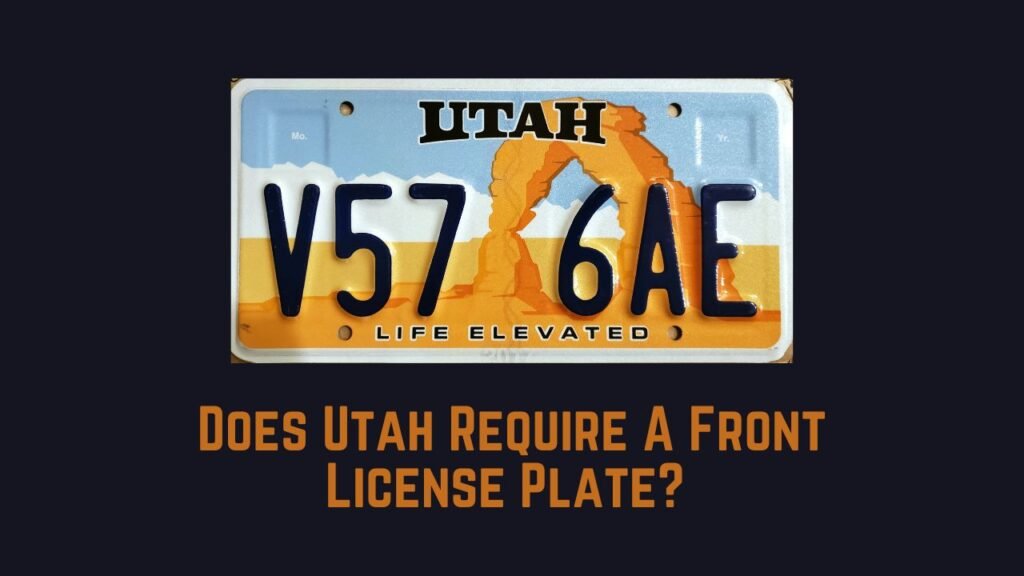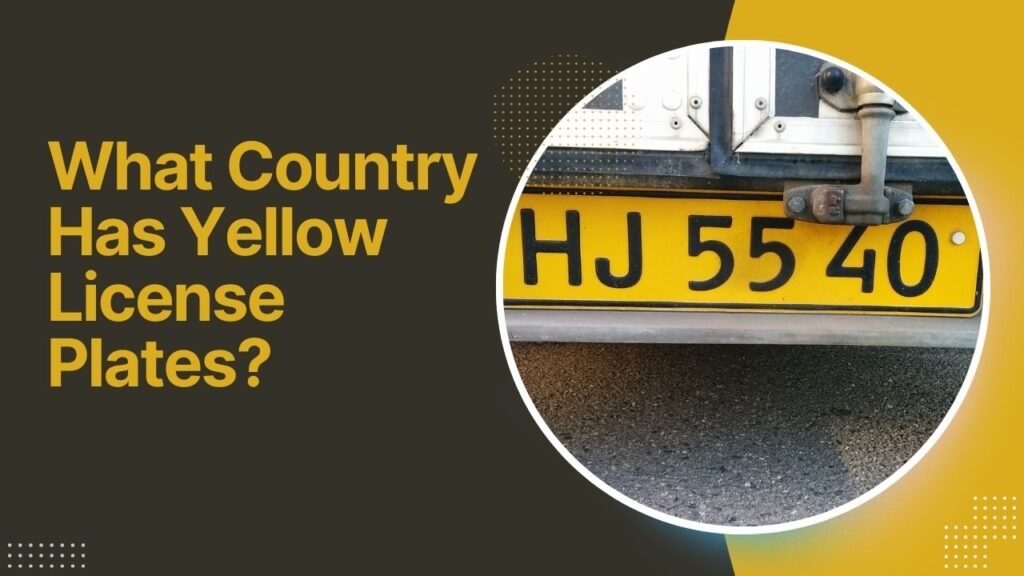Does Utah Require A Front License Plate? As of November, 2024, Utah requires vehicles to display both front and rear license plates. However, starting January 1, 2025, the state will no longer mandate front license plates for most vehicles.
For drivers and car enthusiasts in Utah, the laws around front license plates have been a longstanding discussion point.
Many Utah residents, particularly those who drive newer or high-end vehicles, have expressed concerns about the need for a front plate, given its aesthetic impact and the practical challenges of fitting it on modern car designs.
Recently, Utah has made a significant update to its license plate requirements that reflects changing trends and legislative priorities. [Does Utah Require A Front License Plate?]
In this article, we’ll look at the current state of Utah’s front license plate law, the upcoming changes set to take effect in 2025, the reasoning behind this shift, and the implications it has for vehicle owners across the state.
Contents
Current Law: Do Utahns Need a Front License Plate?
As of 2024, Utah requires all registered vehicles to display both front and rear license plates. This aligns with the laws in several other states where two plates are mandated.
The reasoning behind a two-plate requirement is simple: it helps law enforcement and emergency responders quickly identify vehicles from both directions, improving public safety and assisting in the tracking and identification of vehicles in high-speed or high-traffic areas.
Let’s break down the main reasons why Utah currently mandates both front and rear license plates:
Enhanced Law Enforcement Capabilities
One of the primary reasons for the two-plate requirement is to make it easier for law enforcement to identify vehicles from multiple angles. [Does Utah Require A Front License Plate?]
For instance, a front license plate can be particularly helpful in incidents involving toll cameras, red-light cameras, or instances where the back of a vehicle isn’t visible, such as at certain intersections or during pursuits.
Public Safety and Efficiency
Beyond helping law enforcement, two plates allow for easier identification during emergencies or accidents.
Emergency responders rely on clear identification to manage situations efficiently, especially in areas with high traffic volumes.
Having a front plate can make a significant difference in speeding up response times or verifying a vehicle’s registration.
Contribution to State Revenue
In addition to the safety benefits, requiring two plates contributes to state revenue through manufacturing, issuance, and registration fees.
This revenue helps fund public projects and state services, which are indirectly supported by the fees collected from plate issuance. [Does Utah Require A Front License Plate?]
Although seemingly minor, the fees associated with manufacturing and replacing two plates contribute to the state’s budget in a meaningful way.
Changes Coming in 2025: What Will the New Law Entail?
Starting January 1, 2025, Utah will no longer require a front license plate for most standard vehicles.
This change aligns Utah with several other states that have decided to allow single rear plates on certain vehicles.
Let’s explore the specifics of the upcoming law and the reasons that prompted Utah lawmakers to make this change. [Does Utah Require A Front License Plate?]
The New Exemptions
Under the new law, most standard vehicles, including passenger cars and light trucks, will only need to display a single rear license plate.
However, specific vehicle types, such as large commercial trucks or vehicles with unique safety requirements, may still be required to display a front plate.
This exception ensures that certain vehicles, which require a higher level of visibility for safety reasons, remain identifiable from both directions.
Aligning with Neighboring States
Utah’s move to relax its front plate requirement reflects a growing trend among several states that have already shifted to single-plate laws for specific types of vehicles.
Neighboring states like Arizona and New Mexico have long operated with a one-plate system for most vehicles, which has been well-received by residents. [Does Utah Require A Front License Plate?]
Utah lawmakers recognized the need to modernize its requirements to match broader regional standards and accommodate the preferences of its residents.
Why the Change?
Utah’s decision to move away from mandatory front plates for all vehicles stems from a combination of public input, changes in vehicle design, and advances in tracking technology.
Many car owners expressed concerns over the difficulty of mounting a front plate on newer models that lack a designated front plate holder.
Additionally, front plates can interfere with vehicle sensors and aesthetics, particularly on luxury or sports vehicles.
Lawmakers also acknowledged that today’s technology, including enhanced surveillance systems and better tracking methods, reduces the reliance on front plates for identification purposes.
Potential Impact on Vehicle Modifications
Vehicle enthusiasts and collectors have been particularly supportive of this change. [Does Utah Require A Front License Plate?]
Many newer or high-end vehicles, especially sports cars, are designed without a dedicated front plate area, and installing one can sometimes mean costly modifications or aftermarket solutions.
By eliminating the need for front plates, owners of such vehicles can now maintain their cars in a more original condition without the need to add a front plate bracket or potentially damage the front bumper.
Advantages and Drawbacks of the New Law
While the new law brings several advantages to Utah residents, there are also some drawbacks and considerations for law enforcement and public safety officials.
Advantages for Vehicle Owners
- Aesthetic Appeal
Many drivers, particularly those who own high-end or vintage vehicles, prefer the appearance of a single rear plate. Eliminating the front plate requirement improves the visual appeal of their vehicles and preserves the design integrity intended by the manufacturer. [Does Utah Require A Front License Plate?] - Reduced Costs
While it may seem minimal, the cost associated with issuing and replacing two plates adds up for both the state and car owners. This change may result in slightly lower registration costs, saving residents a small amount of money over time. - Simplified Installation
Without the need for a front plate, car owners no longer have to worry about complex mounting processes, which can sometimes damage the vehicle’s aesthetics or involve aftermarket solutions. For certain vehicles, adding a front plate requires custom installations that can be costly and complicated.
Potential Drawbacks
- Challenges for Law Enforcement
One concern voiced by law enforcement is that a front license plate provides an additional identification point, particularly in situations where the rear plate is not visible. This can be a disadvantage in high-speed incidents or when only the front of a vehicle is facing a surveillance camera or observer. [Does Utah Require A Front License Plate?] - Automated Systems Adjustments
Certain automated monitoring systems, including toll cameras and red-light cameras, are designed to capture images of front plates. Removing the front plate requirement means these systems may need updates or reconfiguration, which could involve additional expenses for the state or municipalities. - Loss of Revenue for the State
While the cost savings for drivers may be appreciated, Utah’s decision to forgo front plates for most vehicles could lead to a decrease in revenue from plate manufacturing and associated fees. The state may need to adjust its budget or find alternative sources of revenue to cover this gap. [Does Utah Require A Front License Plate?]
How Will This Change Affect Utah Residents?
This new law is expected to have widespread effects on Utah residents, primarily benefiting car enthusiasts and those with modern vehicles where a front plate might interfere with aesthetics or functionality.
Here’s how it may impact different segments of the population:
Vehicle Owners of Luxury and Sport Models
Many luxury and sport models do not come with dedicated front plate brackets. [Does Utah Require A Front License Plate?]
Car owners of these models can now enjoy an uninterrupted vehicle design without compromising the bumper or grille for a front plate.
This is particularly beneficial for collectors and enthusiasts who value the design integrity of their vehicles.
Daily Commuters and Family Vehicles
For everyday drivers, the impact may be minimal beyond the slight savings on registration fees.
However, the simplified registration process and minor cost reduction could provide a welcome convenience for Utah families who rely on multiple vehicles.
Commercial Vehicle Owners
It’s worth noting that certain commercial and large vehicles may still require a front plate. [Does Utah Require A Front License Plate?]
This requirement is in place to ensure visibility for vehicles that may have higher safety and tracking needs.
Business owners with fleets may need to verify specific regulations as the new law goes into effect.
See Also: What To Do If Your License Plate Is Stolen?
FAQs
Will I be required to remove my front license plate after January 1, 2025?
No, you are not required to remove it. You may keep both plates if you prefer, as long as the rear plate is visible and properly affixed.
Will there be any change in the registration process?
The registration process will remain largely the same, but you may see a slight reduction in costs since only one plate will be issued for most vehicles.
Are there exceptions to the new rule?
Yes, certain vehicles, such as large commercial trucks, may still need to display a front plate for visibility and safety purposes. [Does Utah Require A Front License Plate?]
Will my current two-plate registration still be valid?
Yes, your current registration remains valid. The new law simply provides the option to remove the front plate if your vehicle is eligible.
Could this law change in the future?
Like all regulations, license plate requirements may evolve over time. However, for now, the one-plate option is set to begin in 2025.
Final Thoughts: Does Utah Require A Front License Plate?
Utah’s decision to relax its front license plate requirement reflects modern vehicle trends, advances in law enforcement technology, and the growing desire for flexibility among residents.
The shift to a single rear plate option provides added freedom for car owners, minimal cost savings, and aligns Utah’s policies with other states that have adapted to modern automotive needs.
This new law promises a balance between maintaining vehicle identification for safety and providing Utah drivers with an aesthetic and practical improvement. For Utah residents, the time to prepare for this change is now.
Whether you’re a car enthusiast thrilled by the design benefits or simply looking forward to the convenience of single-plate registration, this new legislation offers a practical and welcome update to Utah’s vehicle requirements.

I’m Karsyn Marsh, a blogger from a small village in Texas. I enjoy writing about many topics, and right now, I’m focused on license plates. I share helpful information and facts on LicensePlateFacts.com.



